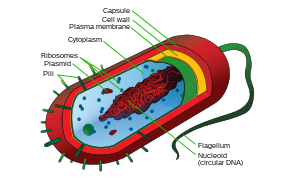BY1: Cell Structure
- Created by: Ethan Nelson
- Created on: 20-05-13 16:35
Cell Overview
Nucleus
-The most prominent feature, spherical and about 10-20 nanometres in diameter.
-To control cell activity and retain genetic information (chromosomes).
-Bounded by a double membrane (nuclear membrane), and is continous with ER.
-Has pores to allow passage of mRNA out of the nucleus.
-Contains granular neucleoplasm, containing chromatin (coils of DNA around histones).
-Nucleolus' function is to manufacture RNA, needed to make ribosomes.
Mitochondria
-Rod-shaped, and about 10 nanometres in length.
-Double-membrane seperated by a fluid-filled membrane, infolding forms cristae.
-Organic matrix contains protein, lipids and DNA that allows production of its own proteins.
-Site of aerobic respiration, take place in matrix/inner membrane; providing large surface area.
-Producing ATP (the energy carrier molecule), which metabolically active cells require more of; thus needing more mitochondria.
Endoplasmic Reticulum (ER)
-An elaborate system of flattened sacs, with fluid-filled spaces called cisternae.
-Connected with nuclear membrane and often the Golgi; allowing molecule transport.
-Two types:
.Rough ER - Studded with ribosomes, functioning in transporting proteins made by them, present in multitude in cells that produce enyzmes that require secreting.
.Smooth ER - Lack ribosomes, produce and transport lipids.
-Cells that need to store molecules have extensive ER, such as liver/secretory cells.
Ribosomes
-Found in both eukaryotic (80s) and prokaryotic cells (70s).
-Occur in cytoplasm or on rough ER.
-Made up of one large, and one small subunit.
-They are made in nucleus from rRNA and protein.
-Crucial for protein synthesis.
Golgi Body/Apparatus
-Similar to ER but is more compact, formed from pinched off rough ER.
Functions:
-Proteins are transported by vesicles and modified into glycoproteins.
-Packaging glycoproteins into secretory vesicles for exocytosis.
-Secreting other carbohydrates.
-Transporting and secreting lipids.
-Forming lysosomes.
Lysosomes
-Small vacuoles formed from pinched off Golgi.
-Contain digestive enzymes to destroy worn-down organelles.
-They can also digest material that had been taken into the cell (i.e. phagocytosis).
^Easy enough.
Centrioles
-Found in animal cells, consisting of two hollow cylinders at right angles.
-During cell division move to opposite poles of the cell to form the spindle fibre.
Chloroplast
-Found in plant cells, photosynthesising tissue.
-Surrounded by a double membrane.
-The stroma is fluid-filled, and contains ribosomes, DNA and starch.
-Contains flattened sacs called thykaloids, which forms a stack called a granum.
-These contain the chlorophyll for photosynthesis.
Vacuole
-Plants have a large permanent vacuole, single membrane (tonoplast).
-Contain cell sap, storing glucose (etc.); and provide an osmotic system.
Cell Wall
-The plant cell wall consists of cellulose.
-It is fully permeable to water, and it resists breaking when cell becomes turgid.
-As the microfibrils are very strong, provides strength.
-Endables cells to connect via plasmodesmata.
Plant/Animal Cell Comparison
Plant
-Cell wall.
-Chloroplasts present.
-Large single vacuole, full of cell sap.
-No centrioles.
-Plasmodesmata.
-Starch grains for storage.
Animal
-No cell wall.
-No chloroplasts.
-Small, temporary vacuoles.
-Centrioles.
-No plasmodesmata.
-Glycogen granules for storage.
Organisation
Differentiations between cells:
-Shape: nerve cells are long and thin to carry impulses.
-Number of an organelle: liver cells require many mitochondria.
-Contents of cell: red blood cells are packed with haemoglobin.
Tissue = Specialised cells of the same type working together for a particular function, for example epithelial cells which provide protection/secreting function.
Organ = One or more tissues made up for a functional unit (i.e. eye for sight).
System = Collection of organs (i.e. reproductive).
Organisms = All the systems working together.
Prokaryote/Eukaryote Cell Comparison
Prokaryotic
-Found in bacteria.
-No membrane-bound organelles.
-Smaller ribosomes.
-DNA free in cytoplasm.
-No nuclear membrane or ER.
-Cell wall contains murein.
Eukaryotic
-Found in fungi, animals, and plants.
-Membrane-bound organelles.
-Larger ribosomes.
-DNA on chromosomes.
-Distinct nuclear membrane.
-Cell wall in plants is cellulose, in fungi is chitin.
Prokaryote

Viruses
-Can only be seen with an electron microscope.
-Have no cytoplasm, no organelles, or chromosomes.
-Outside a cell they live as an inert virion, and invade a cell to take over metabollism.
-Made up of a nucleic acid core, and a protein coat; the capsid.
-Most animal-attacking have DNA, others contain RNA.
Related discussions on The Student Room
- I enjoy chem practicals more than bio practicals. Is a chem degree right for me? »
- How to answer 6-mark questions in A-Level Biology? »
- Personal statement help for biological natural sciences »
- Dee’s A*AA Journey »
- What is DNA repair »
- 25 marker essay biology »
- 25 mark essay question »
- Advanced Higher Biology Project Ideas »
- Magnesium melting point »
- Please help this is due tomorrow »
Comments
No comments have yet been made